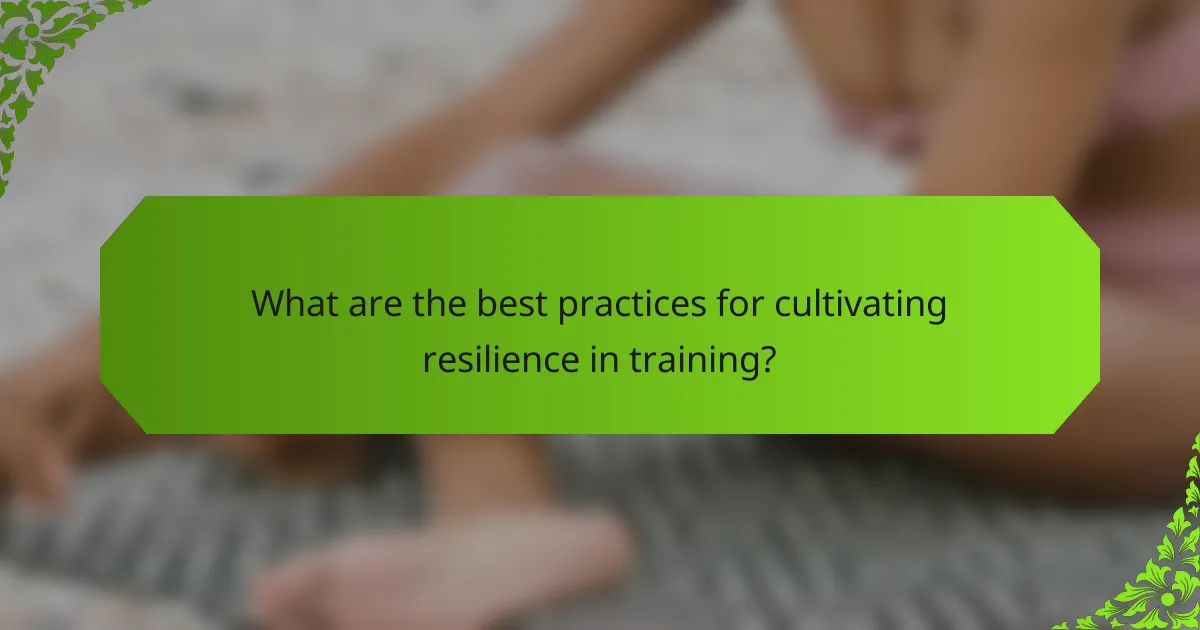Building resilience is crucial for amateur athletes facing unique challenges in their sports journey. This article explores effective techniques such as mental training, goal setting, and positive self-talk. It also emphasizes the importance of developing a growth mindset and creating a supportive network. Finally, it highlights the role of mindfulness and visualization in enhancing focus and emotional regulation.

What are the key resilience techniques for amateur athletes?
Amateur athletes can enhance resilience through mental training, goal setting, and positive self-talk. These techniques foster a growth mindset, enabling athletes to overcome challenges and setbacks. Practicing mindfulness and visualization can improve focus and emotional regulation. Regular reflection on experiences helps identify strengths and areas for improvement, reinforcing resilience over time.
How do resilience techniques enhance athletic performance?
Resilience techniques significantly enhance athletic performance by fostering mental toughness and adaptability. These techniques help athletes manage stress and maintain focus during competition. Practices such as visualization, goal setting, and mindfulness improve concentration and emotional regulation. Developing a resilient mindset enables athletes to overcome setbacks, ultimately leading to better performance outcomes.
What are the psychological benefits of resilience for athletes?
Resilience offers significant psychological benefits for athletes, enhancing their performance and mental well-being. It fosters a growth mindset, allowing athletes to view challenges as opportunities rather than setbacks. This perspective promotes persistence, helping them overcome obstacles and maintain motivation. Resilience also reduces anxiety and stress, leading to improved focus during competitions. Furthermore, resilient athletes often exhibit greater emotional regulation, enabling them to manage their emotions effectively under pressure. This combination of traits ultimately contributes to sustained athletic success and personal development.
How does resilience contribute to stress management in sports?
Resilience significantly enhances stress management in sports by fostering mental toughness. Athletes with strong resilience can better cope with pressure, setbacks, and challenges, leading to improved performance. Techniques such as positive self-talk, visualization, and goal setting cultivate this resilience. As a result, athletes experience reduced anxiety and heightened focus during competitions.
What practices promote resilience in amateur athletes?
Practices that promote resilience in amateur athletes include mental conditioning, goal setting, and social support. Mental conditioning techniques, such as visualization and mindfulness, enhance focus and reduce anxiety. Setting specific, achievable goals fosters a sense of purpose and motivation. Social support from coaches, peers, and family provides emotional encouragement, which is crucial during challenging times. Together, these practices build a strong resilience mindset, enabling athletes to overcome setbacks and improve performance.
How can goal-setting improve resilience?
Goal-setting enhances resilience by providing clear objectives and a sense of direction. It fosters motivation, enabling amateur athletes to overcome challenges and setbacks. By breaking goals into manageable steps, athletes build confidence and adaptability. This structured approach helps develop a growth mindset, allowing for continuous improvement and perseverance in the face of adversity.
What role does visualization play in developing resilience?
Visualization enhances resilience by enabling amateur athletes to mentally prepare for challenges. It fosters a positive mindset, reduces anxiety, and improves focus. Athletes who visualize their success can better cope with setbacks, as it strengthens their mental fortitude. This technique, a unique attribute of mental training, allows for the creation of effective coping strategies, enhancing overall performance.
How does maintaining a positive mindset foster resilience?
Maintaining a positive mindset enhances resilience by fostering adaptability and encouraging a proactive approach to challenges. A positive outlook helps amateur athletes view setbacks as opportunities for growth, which is crucial for mental fortitude. This mindset promotes persistence, allowing athletes to push through difficulties and maintain focus on their goals. Research indicates that athletes with a positive mindset are more likely to employ effective coping strategies, reducing stress and improving performance. Consequently, developing a positive mindset is essential for building resilience in the competitive sports environment.

What unique challenges do amateur athletes face in building resilience?
Amateur athletes face unique challenges in building resilience, including limited resources, high self-doubt, and inconsistent support systems. These factors can hinder their mental toughness and ability to cope with setbacks. Developing resilience requires tailored strategies that address these specific obstacles. For instance, creating a supportive network or utilizing visualization techniques can enhance their mental fortitude. Cultivating a growth mindset is essential, as it encourages athletes to view challenges as opportunities for growth rather than insurmountable barriers.
How can social support networks enhance resilience?
Social support networks significantly enhance resilience by providing emotional, informational, and practical assistance. This support fosters a sense of belonging, which is crucial for amateur athletes facing challenges. Research indicates that athletes with strong social networks exhibit higher levels of motivation and lower stress, directly impacting their performance. Furthermore, these networks facilitate skill sharing and collective problem-solving, enabling athletes to navigate setbacks more effectively.
What are the unique resilience strategies for different sports?
Different sports employ unique resilience strategies tailored to their specific demands. For instance, endurance sports often focus on mental stamina and visualization techniques, while team sports may emphasize communication and supportive relationships. Individual sports frequently require self-discipline and personal goal setting. These strategies enhance performance and foster a positive mindset among amateur athletes.
How do team dynamics influence resilience in team sports?
Team dynamics significantly enhance resilience in team sports by fostering collaboration and support. Strong relationships among team members create an environment where athletes feel safe to take risks and learn from failures. This support system encourages a growth mindset, leading to improved performance under pressure. Effective communication and shared goals also strengthen team cohesion, further boosting resilience. Ultimately, positive team dynamics cultivate a culture of perseverance, enabling athletes to overcome challenges together.
What individual strategies work best for solo sports?
Resilience techniques for solo sports focus on mental strength and adaptability. Key strategies include visualization, goal-setting, and positive self-talk. Visualization helps athletes mentally prepare for competition, enhancing performance. Goal-setting provides clear objectives, fostering motivation and focus. Positive self-talk combats negative thoughts, promoting confidence and resilience. These practices collectively build a robust mindset essential for overcoming challenges in solo sports.

What rare attributes contribute to exceptional resilience in amateur athletes?
Exceptional resilience in amateur athletes often stems from rare attributes such as adaptability, mental toughness, and intrinsic motivation. These traits enable athletes to navigate challenges and setbacks effectively. Adaptability allows athletes to adjust strategies in response to changing circumstances. Mental toughness fosters perseverance, enabling them to push through physical and psychological barriers. Intrinsic motivation drives a passion for improvement, fueling consistent training and performance enhancement. Together, these rare attributes contribute significantly to an athlete’s overall resilience, enhancing their ability to succeed in competitive environments.
How do personal experiences shape resilience in athletes?
Personal experiences significantly shape resilience in athletes by fostering adaptability and mental toughness. These experiences often include overcoming injuries, facing competition pressures, and learning from failures. Each challenge enhances problem-solving skills and emotional regulation, which are crucial for maintaining performance under stress. Additionally, supportive relationships and mentorship can provide valuable insights, reinforcing a positive mindset. As a result, athletes develop a robust framework for resilience that can be applied throughout their careers.
What role does adaptability play in resilience?
Adaptability is crucial for resilience as it enables amateur athletes to adjust to challenges and setbacks effectively. By cultivating adaptability, athletes can respond to changing circumstances, such as injuries or performance fluctuations, without losing motivation. This flexibility fosters a growth mindset, allowing athletes to view obstacles as opportunities for improvement. Research shows that adaptable individuals are more likely to maintain focus and recover from disappointments, enhancing their overall performance and well-being.

What are the best practices for cultivating resilience in training?
Cultivating resilience in training involves consistent practices that enhance mental strength. Key techniques include setting realistic goals, maintaining a positive mindset, and embracing challenges.
1. Set specific, achievable goals to foster a sense of accomplishment.
2. Practice mindfulness to stay focused and reduce stress.
3. Embrace setbacks as learning opportunities to build adaptability.
4. Develop a strong support network for encouragement and motivation.
5. Incorporate visualization techniques to enhance confidence and performance.
6. Regularly reflect on progress to reinforce resilience and growth.
These practices empower amateur athletes to navigate challenges effectively, ultimately enhancing their performance and enjoyment in sports.
How can athletes avoid common mistakes in resilience training?
Athletes can avoid common mistakes in resilience training by focusing on structured practices and maintaining a positive mindset. Establish clear goals to measure progress and adapt techniques as needed. Incorporate recovery strategies to prevent burnout and ensure mental flexibility. Engage in consistent self-reflection to identify areas for improvement and reinforce resilience-building habits.
What expert insights can help athletes develop resilience effectively?
Athletes can develop resilience effectively through mental strategies, supportive environments, and adaptive practices. Techniques such as visualization, goal-setting, and mindfulness enhance focus and coping skills. These methods foster a growth mindset, enabling athletes to embrace challenges and learn from setbacks. Research indicates that resilience training can lead to improved performance and well-being in sports.
What are top tips from sports psychologists on building resilience?
Top tips from sports psychologists for building resilience include developing a growth mindset, setting realistic goals, and practicing self-compassion. These techniques enhance mental strength and adaptability in challenging situations. Regular visualization and mindfulness exercises can also improve focus and emotional regulation. Engaging in positive self-talk fosters a supportive inner dialogue, crucial for overcoming setbacks.
How can athletes implement resilience techniques in daily training?
Athletes can implement resilience techniques in daily training by integrating mental strategies, physical challenges, and reflective practices. These techniques enhance focus, improve adaptability, and foster a growth mindset.
For example, athletes can practice visualization to mentally rehearse challenging scenarios, which builds confidence. Incorporating interval training can physically simulate stress, teaching athletes to manage fatigue and discomfort. Regular reflection on training sessions helps identify strengths and areas for improvement, reinforcing learning and resilience.
By consistently applying these techniques, athletes cultivate a resilient mindset that supports long-term performance goals.
